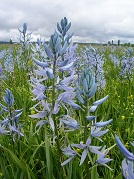Nez Perce National Historical Park personnel are monitoring camas (Camassia quamash) at Weippe Prairie.

NPS
Nez Perce National Historical Park personnel are monitoring camas (Camassia quamash) at Weippe Prairie. On their trek to the Pacific, members of the Lewis and Clark expedition first encountered the Nez Perce Tribe at Weippe Prairie, harvesting camas bulbs to eat. Over the years, this wet meadow system has been over-grazed, ditched, drained and farmed, greatly decreasing the number of camas. When the NPS acquired this property, its intent was to monitor and restore camas to this National Historic Landmark. A few of the NPS efforts underway include an education program for monitoring the camas with three high schools, one of which enrolls a majority of Nez Perce tribal members. The students learn natural and cultural information about camas and scientific methods for monitoring camas, and then monitor camas in the meadow. In addition, a graduate student from Oregon State University is using western science to test traditional ecological knowledge for the propagation and management of camas. Traditional ecological knowledge and thoughts continue to guide the Park’s research of camas at Weippe Prairie.
Last updated: January 13, 2016
